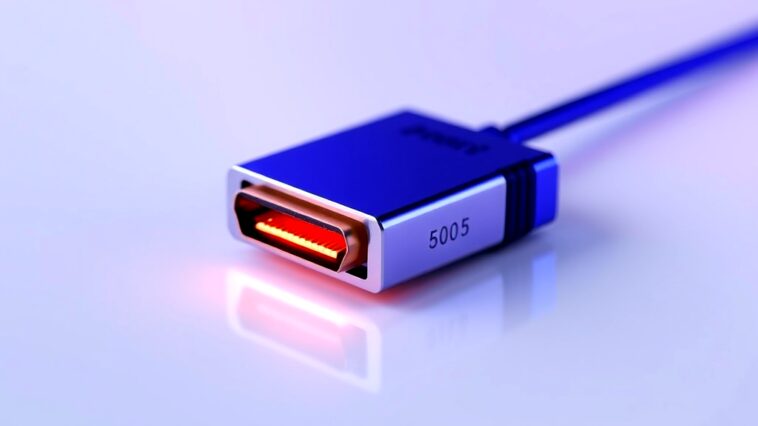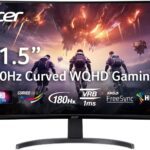If you’ve ever connected your computer to a monitor or a gaming console to a TV, you’ve likely encountered video cables and ports. One of the latest advancements in this area is the DisplayPort 2.1. But what is it, and why should you care? Let’s break it down in a way that makes sense for everyone, from tech enthusiasts to those just looking to improve their home setup.
Understanding DisplayPort
DisplayPort is a digital display interface developed by the Video Electronics Standards Association (VESA). It’s a way for your computer (or other devices) to communicate with monitors, projectors, and TVs. Think of it as a bridge that carries video and audio signals from one device to another.
Why Does DisplayPort Matter?
The reason DisplayPort is significant is that it keeps getting better. With each new version, it supports higher resolutions, faster refresh rates, and more features. This means that you can enjoy clearer images, smoother motion, and more vibrant colors.
The Evolution of DisplayPort
To understand DisplayPort 2.1, we should start by looking briefly at its predecessors:
- DisplayPort 1.2: Introduced features like 4K resolution support and Multi-Stream Transport (MST), allowing multiple monitors to be connected in a daisy-chain.
- DisplayPort 1.4: This version added support for High Dynamic Range (HDR) and improved compression technologies.
- DisplayPort 2.0: Launched with even higher bandwidth capabilities, but it was DisplayPort 2.1 that made it more practical for consumers.
What Is DisplayPort 2.1?
DisplayPort 2.1 is the latest version of the DisplayPort standard. It offers some exciting upgrades that make it a great option for gamers, content creators, and anyone in need of high-quality video output. Here are the key features:
Maximum Bandwidth of 80 Gbps
One of the standout features of DisplayPort 2.1 is its maximum bandwidth, which can reach up to 80 Gbps. To put this in perspective, that’s nearly three times the bandwidth of DisplayPort 1.4, which maxed out at 32.4 Gbps. This increased bandwidth means:
- Higher Resolutions: You can run displays with incredibly high resolutions, such as 8K and even 16K.
- Faster Refresh Rates: Enjoy smoother visuals, especially in gaming, where high refresh rates (like 240Hz) can make a big difference.
Support for Advanced Technologies
DisplayPort 2.1 isn’t just about raw power; it also supports advanced technologies that enhance your viewing experience:
- Display Stream Compression (DSC):
- This technology allows for visually lossless compression, so even at higher resolutions, your visuals look amazing without sacrificing quality.
- With DSC, you can achieve ultra-high resolutions like 16K at 60Hz without any noticeable loss in image quality.
- Multi-Stream Transport (MST):
- MST lets you connect multiple monitors through a single DisplayPort connection, making it easy to set up extended displays for multitasking or gaming.
- Link Training Tunable PHY Repeaters (LTTRPs):
- These help ensure that your signal remains strong and clear, even over longer cable lengths.
Backward Compatibility
One of the best things about DisplayPort 2.1 is that it is backward compatible with older versions. This means:
- You can connect a DisplayPort 1.4 device to a DisplayPort 2.1 monitor (but you’ll only get the capabilities of the older version, like 32.4 Gbps).
- This compatibility helps you protect your investment in older technology while upgrading to newer displays.
Real-World Applications of DisplayPort 2.1
Now that we understand what DisplayPort 2.1 is and what it offers, let’s look at how it can benefit you in practical terms.
Gaming
For gamers, having a high refresh rate and resolution can dramatically enhance gameplay. Imagine playing your favorite game in 4K at 240Hz or even 8K at 60Hz. The visuals would be crisp, and the experience would be smooth, allowing you to react faster to fast-paced action.
Example: Gaming Setup
Let’s say you’re playing a racing game. With DisplayPort 2.1, you could connect a monitor that supports 4K at 240Hz. That means every time you turn, your view would be fluid and clear, making it feel like you’re actually behind the wheel. This could give you a competitive edge against others playing on lower refresh rates.
Content Creation
For video editors and graphic designers, having high-resolution displays is essential. Working with high-quality images and videos means you need a connection that can handle large data files without lagging.
Example: Video Editing
Imagine you’re editing a 4K video. With DisplayPort 2.1, you could work seamlessly on a monitor that supports 8K resolution. This means that you can see every detail of your footage, making it easier to edit and produce stunning visuals.
Home Theater Systems
If you’re a movie buff, DisplayPort 2.1 can enhance your home theater setup. You can enjoy stunning visuals on large screens with high resolutions and refresh rates.
Example: Movie Watching
Picture this: You sit down to watch an action-packed movie in 16K resolution. With the right setup using DisplayPort 2.1, you’d experience incredibly lifelike images that pull you right into the action, making your movie nights unforgettable.
The Importance of Cables
To take full advantage of DisplayPort 2.1, you need the right cables. Not all DisplayPort cables are created equal. Here’s what you should know:
Types of Cables
- DP40 Cable:
- Capable of supporting 40 Gbps for certain modes (UHBR10).
- DP80 Cable:
- This cable supports up to 80 Gbps, allowing you to utilize all the features of DisplayPort 2.1.
Physical Differences
There’s no difference in functionality between the full-sized DisplayPort and mini DisplayPort; it’s just about the size of the connector. However, when it comes to lengths, most DP80 cables are currently limited to about 1.2 meters (about 4 feet).
Choosing the Right Cable
When shopping for cables, look for labels indicating their capabilities. Make sure the cable you purchase can handle the bandwidth you need for your device and monitor to maximize performance.
DisplayPort 2.1 Devices
As DisplayPort 2.1 becomes more common, you may wonder what devices support it. Here are a few key points:
Graphics Cards
- AMD RX 7000 Series: These graphics cards support DisplayPort 2.1 with UHBR13.5, allowing for excellent performance with high refresh rates.
- NVIDIA 4000 Series: While these graphics cards are powerful, they may not fully utilize DisplayPort 2.1 capabilities, as they have limitations in refresh rates when used with certain monitors.
Monitors
Currently, there are a few monitors on the market that support DisplayPort 2.1 features. Notably:
- Samsung Odyssey Neo G95NC: This monitor offers a 7680×2160 resolution at 240Hz, making it a top choice for gamers.
- Other Displays: More monitors are expected to come onto the market, showcasing the benefits of DisplayPort 2.1.
Example of Compatibility
Suppose you have an AMD RX 7000 graphics card connected to the Samsung Odyssey monitor. You would enjoy smooth gameplay at high resolutions, making your gaming setup future-proof.
Common Misconceptions
With new technology, there are often misunderstandings. Here are a few common misconceptions about DisplayPort 2.1:
“All DisplayPort Devices Are the Same”
Not all DisplayPort devices are equal. Just because a monitor has a DisplayPort connection doesn’t mean it can take advantage of DisplayPort 2.1 features. Always check the specifications.
“I Don’t Need Upgraded Cables”
If you want to utilize the full capabilities of DisplayPort 2.1, you must invest in the right cables. Using older cables may limit your performance.
“Backward Compatibility Means I’ll Always Get the Best Quality”
While DisplayPort 2.1 is backward compatible, connecting it to older devices may limit you to the capabilities of the older versions. Always aim to use the best hardware available to take full advantage of the technology.
Why Upgrade to DisplayPort 2.1?
If you’ve made it this far, you might still be wondering if you should upgrade to DisplayPort 2.1. Here are a few compelling reasons to consider:
- Future-Proofing Your Setup: As technology progresses, having a DisplayPort 2.1 setup means you’ll be ready for whatever comes next in high-resolution displays.
- Enhanced Gaming and Viewing Experiences: With its ability to support higher refresh rates and resolutions, you’ll enjoy smoother gameplay and more immersive viewing experiences.
- Versatility: Whether you’re a gamer, content creator, or just enjoy watching movies, DisplayPort 2.1 can significantly enhance your experience.
The Bottom Line
DisplayPort 2.1 is an exciting advancement in video technology that opens up new possibilities for high-quality visuals and smooth performance. With features like 80 Gbps bandwidth, support for multiple high-resolution displays, and backward compatibility, it’s a great option for anyone looking to upgrade their tech setup.
Whether you’re a gamer, a movie enthusiast, or a content creator, DisplayPort 2.1 offers an array of benefits that enhance your experience. As more devices and monitors support this new standard, now is a great time to consider your upgrade options so you can enjoy all the benefits it has to offer.




